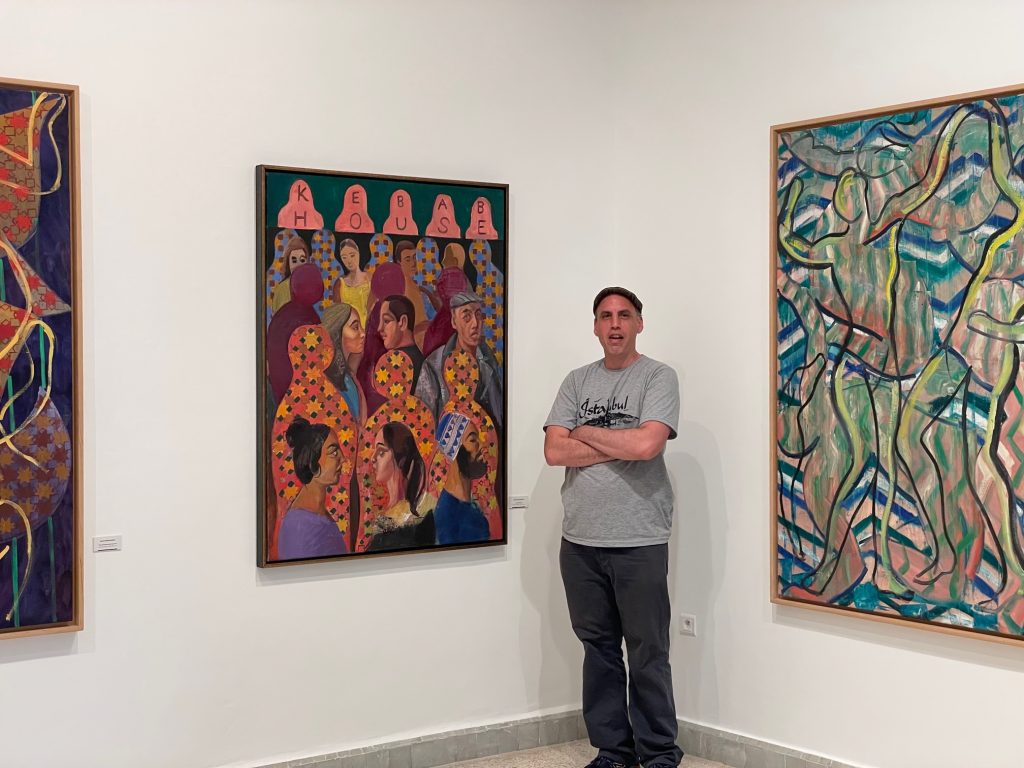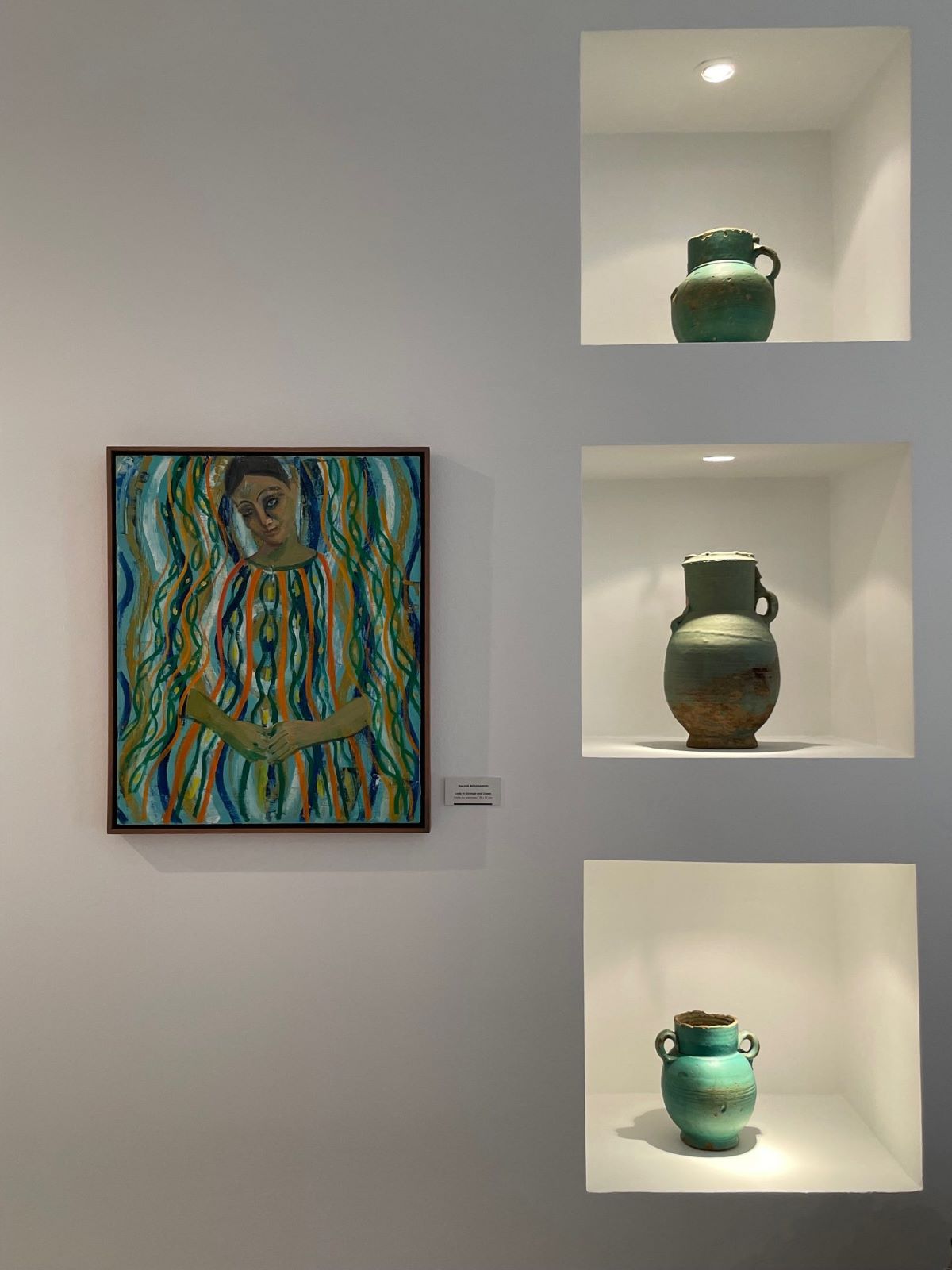 Last Days to See Rachid Bouhamidi’s Show in Marrakech
Last Days to See Rachid Bouhamidi’s Show in Marrakech


Marrakech-based Galerie Tindouf is currently presenting the work of Rachid Bouhamidi (American b. 1981), an alumnus of Boston University (MFA, 2010) and the Art Institute of Chicago (BFA, 2006), who held his first exhibition in Morocco at Galerie SINIYA28 in 2019. The present show, From Palm Springs to La Palmeraie, introduces Bouhamidi’s newest body of work, an exploration into his hybrid identity. With bold, vibrant colours; geometric shapes, forms and patterns; horseback riders; a traditional bride and fish tagine–references of varying degrees of noticeability to Morocco and North Africa–the exhibition takes us on a rather personal tour of Bouhamidi’s expedition into his native country. Read as an ode to Morocco, a country dear to Bouhamidi’s heart, yet also some part foreign in the sense that the artist never lived there, the exhibition manages to both surprise and ignite.


In Bouhamidi’s chronicle, palm trees, synonymous with hybridity, fragmentation and fluidity, play a crucial role. For Bouhamidi, Palm Springs-born Californian whose family emigrated to the US from Morocco a year before he was born, palm trees carry a coalescing meaning as they remind him of a landscape that is both quintessentially Moroccan and Californian, yet also present two rather different worlds. At the same time, the trees also contain a personal emblematic and metaphorical meaning for Bouhamidi. Although nowadays perceived as an iconic LA landscape, palm trees are actually not native to the region, but were originally transplanted from Mexico, Morocco and the Canary Islands to the city of Angels, used as a medium to construct ‘the fictions of the Southland’, as Matt Stromberg (2022) puts it. Similarly, Bouhamidi wrestles with and negotiates his own identity in his work–in part through his beloved palm trees which are a reference to his heritage’s geographical strands but also function as a formal device in his oeuvre. Containing multiple visions of reality from the lush oases of North Africa, the beaches of the French Riviera and the dirty boulevards of Hollywood, the palm trees are also an essentially loaded metaphorical device, once an integral component of the colonial imaginary. Superficially, the trees could be read as part of the visual corpus presenting Morocco, but in Bouhamidi’s treatment, the palm trees transform into a complicated metaphor discussing belonging, roots and origin–both a critique towards our shallow way of attributing ancestry, but also a personal trope highlighting the complexities of belonging and acceptance. In this show, Bouhamidi presents us several iterations of the palm trees which occupy a central stage, often presented against a geometric background, suggesting visitors to pay attention to their formal structure, as exemplified by Transfigured Palm (2022).


For Bouhamidi, once a kid hooked on comics, punk rock and art, Black Flag and Francisco Goya, growing up between California and Morocco, the habit of layering Moroccan, French and Angeleno aesthetics and cultural references resulting to rich depictions lying somewhere between abstraction and figuration and portraiture and pattern, painting feels rhythmic and energetic. The artist excels at creating a sense of grandeur by combining bold, vibrant geometric backgrounds–which remind us of the very foundations of Islamic art and are an integral part of the visual vocabulary translating Morocco–with simplified, almost abstracted figures, resulting in mythical compositions dictated by movement and rhythm, as seen in Two Dancers (2021).


A particular geometric device particularly visible in this body of work is the Rub-el-Hizb, the eight-pointed Islamic Star, which contains a personal significance for Bouhamidi, who decided to become an artist at the age of 14 after attending an exhibition of etchings by Goya in Pomona. The star, on Bouhamidi’s canvas, is arranged in interlocking tessellations, acting as a counter drop for Matisse-like silhouettes and scenes of traditional Moroccan horseback riders. The shape’s personal significance culminates in the Ronda cards, a popular game in Morocco which he used to play with his family, which contain the same symbol. Arguably, therein lies the beauty of Bouhamidi’s current show, too: in the artist’s skilful presentation of a topic that is enormously personal yet dealt in a manner that does not feel too intimate but allows for the subject to exist irrespective of Bouhamidi. Hearing the artist talk about his work is always a great joy and in this case it gives the show another layer–one of added pleasure but not an essential guide–reminding us of artworks’ autonomy and continuance.




 Last Days to See Rachid Bouhamidi’s Show in Marrakech
Last Days to See Rachid Bouhamidi’s Show in Marrakech 

